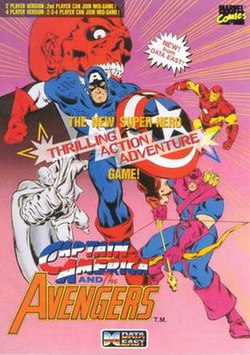Gameplay
The Red Skull has assembled an army of supervillains and other henchmen in a plot to take over the world. Along with battling generic enemies, players also face Klaw, the Living Laser, Whirlwind, a Sentinel, Wizard, the Grim Reaper, the Mandarin, Juggernaut, Ultron, The Controller, the assassin Crossbones and finally the Red Skull himself.
Players can choose to play as one of four members of the Avengers: Captain America, Iron Man, Hawkeye, and Vision. Each character can fight hand-to-hand, throw select items when on the ground, and use a ranged special attack, either a projectile weapon (Captain America's shield and Hawkeye's arrows) or an energy beam (Iron Man and Vision), known as that character's "Avenger Attack". During a jump, Captain America and Hawkeye can attack with a flying kick, while Iron Man and Vision instead attack by firing their energy beams at a 45-degree angle. Other Avengers, including the Wasp, Quicksilver, Wonder Man, and Namor the Sub-Mariner, may appear to help the players' characters.
Most game levels feature side-scrolling fighting, with free movement as in traditional arcade brawlers. Occasionally, players take flight for side-scrolling flying and shooting sequences; Iron Man and Vision fly on their own, while Captain America and Hawkeye use flying machines.
Data East released a home version of the game in North America for the Sega Genesis co-developed with ISCO and Opera House. [8] [9] This version was published in Europe by Sega for the Mega Drive. The game was later licensed to Mindscape, who released its own ports of the arcade game for the Super NES, Game Boy, and Game Gear. The versions published by Mindscape in 1993 were developed by Realtime Associates. [10]
Data East also released a different NES game with the same title. The NES version is a side-scrolling action platform game. The only playable characters in this version are Captain America and Hawkeye; their mission is to save the Vision and Iron Man from Mandarin, then defeat the Red Skull. As with the Genesis/Mega Drive port, the NES game was developed in Japan but not released there.
Data East's third and final entry in their Captain America and The Avengers licensed video games was the 1995 Avengers in Galactic Storm , which was an arcade exclusive fighting game that became the first to feature assist characters and duplex desperation moves.
In 2021, Arcade1Up released the game in a special Marvel-themed cabinet that also featured Avengers in Galactic Storm and X-Men . [11]
This page is based on this
Wikipedia article Text is available under the
CC BY-SA 4.0 license; additional terms may apply.
Images, videos and audio are available under their respective licenses.

